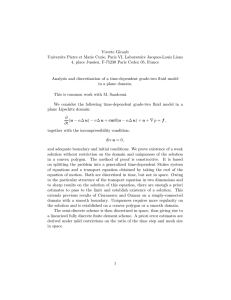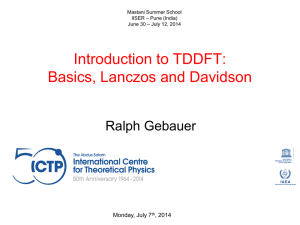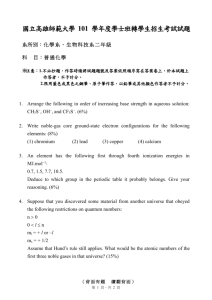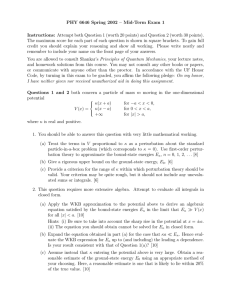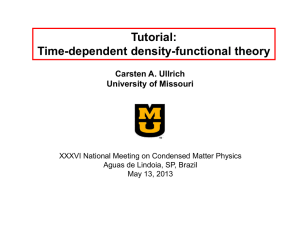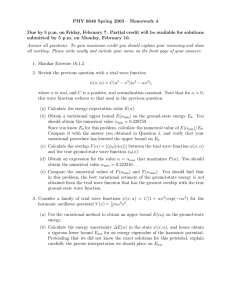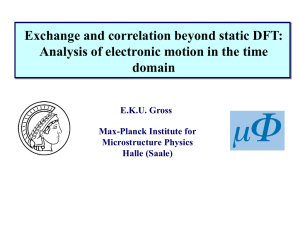1 Basics 1.1 Introduction
advertisement
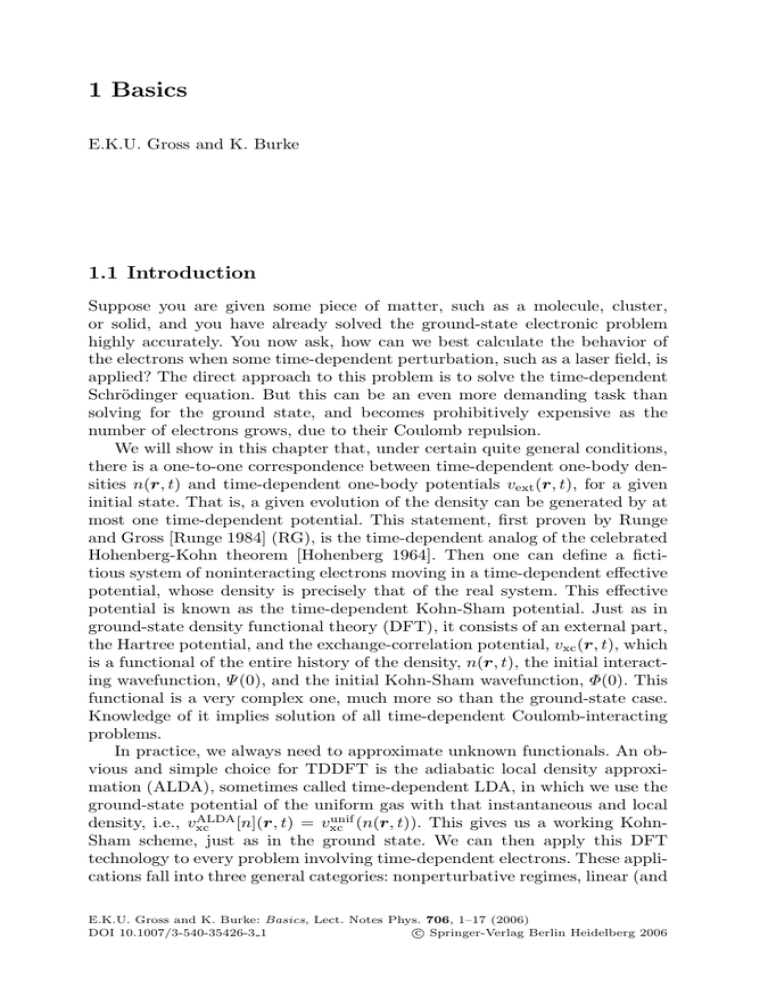
1 Basics
E.K.U. Gross and K. Burke
1.1 Introduction
Suppose you are given some piece of matter, such as a molecule, cluster,
or solid, and you have already solved the ground-state electronic problem
highly accurately. You now ask, how can we best calculate the behavior of
the electrons when some time-dependent perturbation, such as a laser field, is
applied? The direct approach to this problem is to solve the time-dependent
Schrödinger equation. But this can be an even more demanding task than
solving for the ground state, and becomes prohibitively expensive as the
number of electrons grows, due to their Coulomb repulsion.
We will show in this chapter that, under certain quite general conditions,
there is a one-to-one correspondence between time-dependent one-body densities n(r, t) and time-dependent one-body potentials vext (r, t), for a given
initial state. That is, a given evolution of the density can be generated by at
most one time-dependent potential. This statement, first proven by Runge
and Gross [Runge 1984] (RG), is the time-dependent analog of the celebrated
Hohenberg-Kohn theorem [Hohenberg 1964]. Then one can define a fictitious system of noninteracting electrons moving in a time-dependent effective
potential, whose density is precisely that of the real system. This effective
potential is known as the time-dependent Kohn-Sham potential. Just as in
ground-state density functional theory (DFT), it consists of an external part,
the Hartree potential, and the exchange-correlation potential, vxc (r, t), which
is a functional of the entire history of the density, n(r, t), the initial interacting wavefunction, Ψ (0), and the initial Kohn-Sham wavefunction, Φ(0). This
functional is a very complex one, much more so than the ground-state case.
Knowledge of it implies solution of all time-dependent Coulomb-interacting
problems.
In practice, we always need to approximate unknown functionals. An obvious and simple choice for TDDFT is the adiabatic local density approximation (ALDA), sometimes called time-dependent LDA, in which we use the
ground-state potential of the uniform gas with that instantaneous and local
ALDA
unif
[n](r, t) = vxc
(n(r, t)). This gives us a working Kohndensity, i.e., vxc
Sham scheme, just as in the ground state. We can then apply this DFT
technology to every problem involving time-dependent electrons. These applications fall into three general categories: nonperturbative regimes, linear (and
E.K.U. Gross and K. Burke: Basics, Lect. Notes Phys. 706, 1–17 (2006)
c Springer-Verlag Berlin Heidelberg 2006
DOI 10.1007/3-540-35426-3 1
2
E.K.U. Gross and K. Burke
higher-order) response, and ground-state applications. The rapidly growing
number of such applications, and the diversity of systems, ranging from chemistry to biology to materials science, forms the motivation for this book.
The first of these applications involves atoms and molecules in strong
laser fields [Marques 2004], in which the field is so intense that perturbation theory does not apply. In these situations, the perturbing electric field
is comparable to or much greater than the static electric field due to the
nuclei. Experimental aims would be to enhance, e.g., the 27th harmonic,
i.e., the response of the system at 27 times the frequency of the perturbing electric field [Christov 1997], or to cause a specific chemical reaction to
occur (quantum control) [Rice 2000]. Previously, only one and two electron
systems could be handled computationally, as full time-dependent wavefunction calculations are very demanding [Parker 2000]. Crude and unreliable
approximations had to be made to tackle larger systems. But with the advent of TDDFT, larger systems with more electrons can now be tackled (see
Chaps. 22, 23, 26 and 27).
When the perturbing field is weak, as in typical spectroscopic experiments,
perturbation theory applies. Then, instead of needing knowledge of the functional vxc [n](r, t) at densities that are changing significantly with time, which
might differ substancially from a ground-state density, we only need to know
this potential in the vicinity of the initial state, which we take to be a nondegenerate ground-state. These changes are characterized by a new functional,
the exchange-correlation kernel [Gross 1985]. The exchange-correlation kernel
is much more manageable than the full time-dependent exchange-correlation
potential, because it is a functional of the ground-state density alone. Analysis of the linear response then shows [Appel 2003] that the latter is (usually)
dominated by the response of the ground-state Kohn-Sham system, but corrected by TDDFT via matrix elements of the exchange-correlation kernel. In
the absence of Hartree-exchange-correlation effects, the allowed transitions
are exactly those of the ground-state Kohn-Sham potential. But the presence of the kernel shifts the transition frequencies away from the Kohn-Sham
values to the true values. The intensities of the optical transitions are also
affected by the kernel [Petersilka 1996a, Casida 1996, Rubio 1996].
Several approaches to extracting excitations from TDDFT for atoms,
molecules, and clusters are currenty being used. The standard approach in
quantum chemistry is to very efficiently convert the search for poles of response functions into a large eigenvalue problem [Casida 1996, Görling 1999a,
Furche 2005a], in a space of the single-particle excitations of the system. The
eigenvalues yield transition frequencies, while the eigenvectors yield oscillator
strengths. This allows use of many existing fast algorithms to extract the lowest few excitations (see Chap. 23). In this way, TDDFT has been programmed
into most standard quantum chemical packages [Bauernschmitt 1996a] and,
after a molecule’s structure has been found, it is usually not too costly to
extract its low-lying spectrum [Furche 2005c]. Physicists, on the other hand,
1 Basics
3
tend to solve the time-dependent Kohn-Sham equations by evolving the system in real time in the presence of a weak field [Yabana 1996]. Fouriertransform of the time-dependent dipole matrix element then yields the optical
spectrum. Using either methodology, the number of these TDDFT response
calculations for transition frequencies is growing exponentially at present
[Burke 2005a]. Overall, results tend to be fairly good (0.1 to 0.2 eV errors,
typically), but little is understood about their reliability [Furche 2005c]. Challenges remain for the application of TDDFT to solids [Onida 2002], because
the present generation of approximate functionals (local and semi-local) lose
important effects in the thermodynamic limit, but much work (some reported
in this book) is currently in progress.
The last class of application of TDDFT is, perhaps surprisingly, to the
ground-state problem. One can extract the ground-state exchange-correlation
energy from a response function, in the same fashion as perturbation theory yields expressions for ground-state contributions in terms of sums over
excited states, i.e., via the DFT version of the fluctuation-dissipation theorem [Langreth 1975, Gunnarsson 1976]. Thus, any approximation for the
exchange-correlation kernel of TDDFT yields an approximation to the
exchange-correlation energy, Exc , of ground-state DFT. Although such calculations are significantly more demanding than regular ground-state DFT
calculations [Furche 2001c, Fuchs 2002], they produce a natural method for incorporating time-dependent fluctuations in the exchange-correlation energy.
In particular, as a system is pulled apart into fragments, this approach includes correlated fluctuations on the two separated pieces. While in principle all this is included in the exact ground-state functional, in practice
TDDFT provides a natural methodology for modeling these fluctuations [van
Gisbergen 1995, Kohn 1998, Lein 1999].
1.2 One-to-One Correspondence
The Runge-Gross paper is usually cited as the beginning of modern TDDFT.
There were several calculations before this, including those of Ando [Ando
1977a, Ando 1977b], Peuckert [Peuckert 1978], and of Zangwill and Soven
[Zangwill 1980a], as well as proofs of the one-to-one correspondence under
more limited conditions [Deb 1982]. But the RG paper established this correspondence for a sufficiently general class of problems to make TDDFT
rigorous for most of the subsequent applications.
The evolution of the wavefunction is governed by the time-dependent
Schrödinger equation:
Ĥ(t)Ψ (t) = i
dΨ (t)
,
dt
Ψ (0) given
(1.1)
where Ĥ(t) is the Hamiltonian operator. Because this is a first-order differential equation in time, the initial wavefunction must be specified. We consider
4
E.K.U. Gross and K. Burke
N nonrelativistic electrons, mutually interacting via the Coulomb repulsion,
in a time-dependent external potential. We write
1 2
∇
2 i=1 i
N
T̂ = −
(1.2)
for the kinetic energy, where the label i denotes the particle coordinates
ri . We use atomic units throughout this chapter (e2 = = m = 1) and
so all distances are in Bohr and energies in Hartrees (1 H = 27.21 eV =
627.5 kcal/mol). The electron-electron repulsion is given by
1
1
,
2
|ri − rj |
N
V̂ee =
(1.3)
i=j
where the sum is over all pairs, and the factor of 1/2 avoids double counting.
Last, we denote the one-body potential as
V̂ext =
N
vext (ri , t) ,
(1.4)
i=1
which differs from problem to problem. For a hydrogenic atom with nuclear
charge Z in an alternating electric field of strength E oriented along the zaxis and of frequency ω, vext (r, t) = −Z/r + E · z cos(ω, t). An important
point to note is that only vext (r, t) and the particle number differ in the
many problems we address; the interparticle repulsion and statistics never
change. As the system evolves in time from some initial point (say t = 0), its
one-particle density changes. This electron density is given by
2
3
(1.5)
n(r, t) = N d r2 . . . d3 rN |Ψ (r, r2 , . . . , rN , t)| ,
and has the interpretation that n(r, t)d3 r is the probability of finding any
electron in a region d3 r around r at time t. The density is normalized to the
number of electrons
(1.6)
d3 r n(r, t) = N .
The analog of the Hohenberg-Kohn theorem for time-dependent problems
is the one-to-one correspondence proven by RG [Runge 1984]. We consider N
nonrelativistic electrons, mutually interacting via the Coulomb repulsion, in
a time-dependent external potential. The theorem states that the densities
n(r, t) and n (r, t) evolving from a common initial state Ψ (t = 0) under the
(r, t) (both Taylor expandable
influence of two potentials vext (r, t) and vext
about the initial time 0) eventually differ if the potentials differ by more than
a purely time-dependent (r-independent) function:
(r, t) = c(t) .
∆vext (r, t) = vext (r, t) − vext
(1.7)
1 Basics
5
Under these conditions, there is a one-to-one mapping between densities and
potentials, which implies that the potential is a functional of the density.
We prove this theorem by first showing that the corresponding current
densities must differ. The current density is given by
j(r, t) = N d3 r2 . . . d3 rN {Ψ (r, r2 , . . . , rN , t)∇Ψ ∗ (r, r2 , . . . , rN , t)} ,
(1.8)
where f denotes the imaginary part of f . One can easily prove continuity
from the time-dependent Schrödinger equation, (1.1):
∂n(r, t)
= −∇ · j(r, t)
∂t
(1.9)
Return now to the problem of two different systems [i.e., ∆vext (r, t) = c(t)].
Because the corresponding Hamiltonians differ only in their one-body potentials, the equation of motion for the difference of the two current densities is,
at t = 0:
∂
{j(r, t) − j (r, t)}t=0 = −iΨ0 | ĵ(r, t), {Ĥ(0) − Ĥ (0)} |Ψ0 ∂t
(r, 0)} |Ψ0 = −iΨ0 | ĵ(r), {vext (r, 0) − vext
= −n0 (r)∇{vext (r, 0) − vext
(r, 0)} ,
(1.10)
where n0 (r) = n(r, 0) is the initial density. Thus we see that if, at the initial time, the two potentials differ (by more than just a constant), the first
derivative of the currents must differ. Then the currents will change infinitesimally soon thereafter. One can go further, by repeatedly using the equation
of motion, and considering t = 0, to find [Runge 1984]
∂ k+1
∂k
{j(r,
t)
−
j
(r,
t)}
=
−n
(r)∇
{v(r, t) − v (r, t)}t=0 . (1.11)
0
t=0
∂tk+1
∂tk
If (1.7) holds, and the potentials are Taylor expandable about t = 0, then
there must be some finite k for which the right hand side of (1.10) does not
vanish, so that
(1.12)
j(r, t) = j (r, t) .
For two Taylor-expandable potentials that differ by more than just a trivial
constant, the corresponding currents must be different. This is the first part of
the theorem, which establishes a one-to-one correspondence between current
densities and external potentials.
In the second part, we extend the proof to the densities. Taking the gradient of both sides of (1.11), and using continuity, (1.9), we find
∂ k+2
∂k
{n(r, t) − n (r, t)}t=0 = ∇ · n0 (r)∇ k {vext (r, t) − vext (r, t)}t=0 .
∂tk+2
∂t
(1.13)
6
E.K.U. Gross and K. Burke
Now, if not for the divergence on the right-hand-side, we would be done, i.e.,
(r, t)}/∂tk |(t=0) is nonconstant for some k, then
if f (r) = ∂ k {vext (r, t) − vext
the density difference must be nonzero.
Does the divergence allow some escape from this conclusion? The answer
is no, for any physical density in a finite system. To see this, write
d3 r f (r)∇·[n0 (r)∇f (r)] = d3 r ∇ · [f (r)n0 (r)∇f (r)] − n0 (r)|∇f (r)|2 .
(1.14)
The first term on the right may be written as a surface integral at r = ∞, and
vanishes for all realistic potentials (which fall off at least as fast as −1/r).
If we imagine that ∇f is nonzero somewhere, then the second term on the
right is definitely negative, so that the integral on the left cannot vanish, and
its integrand must be nonzero somewhere. Thus there is no way for ∇f to be
nonzero, and yet have ∇(n0 ∇f ) vanish everywhere [Gross 1990].
Since the density determines the potential up to a time-dependent constant, the wavefunction is in turn determined up to a time-dependent phase,
that in turn cancels out of the expectation value of any operator. Thus the expectation value of any operator is a functional of the time-dependent density
and initial state, completing our proof.
1.3 Time-Dependent Kohn-Sham Equations
Having established that the one-body potential is a functional of the density
and initial state, we next define a fictious system of noninteracting electrons
that satisfy time-dependent Kohn-Sham equations:
∇2
∂ϕj (r, t)
= −
+ vKS [n](r, t) ϕj (r, t) ,
(1.15)
i
∂t
2
whose density,
n(r, t) =
N
|ϕj (r, t)|2 ,
(1.16)
j=1
is defined to be precisely that of the real system. By virtue of the one-to-one
correspondence proven in the previous section, the potential vKS (r, t) yielding
this density is unique. We then define the exchange-correlation potential via:
vKS (r, t) = vext (r, t) + vH (r, t) + vxc (r, t) ,
where the Hartree potential has the usual form,
n(r , t)
,
vH (r, t) = d3 r
|r − r |
(1.17)
(1.18)
1 Basics
7
but for a time-dependent density. The exchange-correlation potential is then
a functional of the entire history of the density, n(r, t), the initial interacting wavefunction Ψ (0), and the initial Kohn-Sham wavefunction, Φ(0). This
functional is a very complex one, much more so than the ground-state case.
Knowledge of it implies solution of all time-dependent Coulomb interacting
problems.
By the arguments of the previous section, if both the interacting and KS
initial wavefunctions are nondegenerate ground states, the xc potential is a
functional of the time-dependent density alone.
In ground-state DFT, the exchange-correlation potential is the functional
derivative of Exc [n]. It would be nice to find a functional of n(r, t) for which
vxc (r, t) was the functional derivative, called the exchange-correlation action. A plausible action was given in the RG paper [Runge 1984]. However, it
turned out later [Gross 1995a] that this action leads to a paradox, namely that
the resulting exchange-correlation kernel (see next section) violates causality. Two different solutions to this problem are offered in this volume (see
Chaps. 2 and 7). In either case, some generalization of the space of densities
is required.
Several extensions and further advances on the Runge-Gross paper will
appear later in this book, or have appered in the literature. Here we make
several points:
• Construction of Potential: The one-to-one correspondence tells us
only that the potential is a functional of the density and initial state,
but not what that functional is. Van Leeuwen gives a constructive procedure for finding such a potential, thereby “solving” the representability
problem for the time-dependent case (see Chap. 2).
• Currents: The first part of the proof produced a one-to-one correspondence between currents and potentials, while to get a density functional,
we needed to invoke a surface condition. This renders the application of
TDDFT to extended systems nontrivial. We will see later in the book that
the first step is easily generalized to produce a one-to-one correspondence
between currents and any vector potential (producing time-dependent
current density functional theory) and that some effects are indeed highly
nonlocal, when expressed as density functionals (see Chap. 5).
• Allowed Time-Dependence: The one-to-one correspondence does not
apply to the adiabatic switching often assumed in perturbation theory,
exp(γt), where γ → 0. Such potentials are singular around their initial
time (−∞ in this case). But one can take the adiabatic limit of wellbehaved potentials, as described in Sect. 11.4.1.
• Initial-State Dependence: Later in this book, it is shown that, while
for one electron the initial state wavefunction is completely fixed by requiring it to yield a given density, for two or more electrons, it is possible
to find more than one initial wavefunction, thereby producing two different KS potentials for a given evolution (see Chap. 4).
8
E.K.U. Gross and K. Burke
• Removal of Initial-State Dependence: Note that a dependence on
the initial wavefunction would render TDDFT useless in practice, as we
would need a different density functional for every possible initial wavefunction. However, if the initial state is a nondegenerate ground state,
then, by virtue of the Hohenberg-Kohn theorem, its wavefunction is a
functional of the ground-state density alone. Then the time-dependent
potential is a functional of the time-dependent density alone. This is the
case for almost all practical applications (see Parts IV and V of this volume).
1.4 Linear Response
In this section, we show how the TDKS equations, with a given approximation for the xc potential, can be used to extract the electronic excitations
of a system. This is a powerful tool for studying, e.g., photoluminescence in
biological molecules (see Chap. 23), where the quantitative treatment of the
absorption spectrum can be key to identifying the underlying mechanism.
In principle, we already have sufficient technology to do these calculations.
Simply perturb the system at time t = 0 with a weak electric field, and then
propagate the TDKS equations for a while, evaluating the dipole of interest
as you go. The Fourier transform of that function of time is precisely the
optical absorption spectrum. In fact, this procedure is followed in many realtime codes, as described in later chapters. However, it is very enlightening
and fruitful to analyze the situation in detail using standard linear response
theory.
When the perturbing field is weak, as in normal spectroscopic experiments, perturbation theory applies. Instead of needing knowledge of vxc for
densities that are changing significantly with time, we need only know this
potential for densities close to that of the initial state, which we take to be a
nondegenerate ground-state. Writing n(r, t) = nGS (r, t) + δn(r, t), we have
vxc [nGS + δn](r, t) = vxc [nGS ](r) + dt d3 r fxc [nGS ](r, r , t − t )δn(r , t ) ,
(1.19)
where fxc is called the exchange-correlation kernel, evaluated on the groundstate density:
δvxc (r, t) .
(1.20)
fxc [nGS ](r, r , t − t ) =
δn(r , t ) n=nGS
While still more complex than the ground-state exchange-correlation potential, the exchange-correlation kernel is much more manageable than the full
time-dependent exchange-correlation potential, because it is a functional of
the ground-state density alone. To understand why fxc is important for linear response, define the point-wise susceptibility χ[nGS ](r, r , t − t ) as the
1 Basics
9
response of the ground state to a small change in the external potential:
d3 r χ[nGS ](r, r , t − t ) δvext (r , t ) ,
(1.21)
δn(r, t) = dt
i.e., if you make a small change in the external potential at point r and time
t , χ tells you how the density will change at point r and later time t. The
ground-state Kohn-Sham system has its own analog of χ, which we denote
by χKS . This function tells you how the noninteracting KS electrons would
respond to δvKS (r , t ), which is quite different from the interacting case. But
both must yield the same density response:
δn(r, t) = dt d3 r χKS [nGS ](r, r , t − t )
× {δvext (r , t ) + δvH (r , t ) + δvxc (r , t )} .
(1.22)
Equating this density change with that of the interacting system, (1.21), and
using the definition of the xc kernel, (1.20), we find the central equation of
TDDFT linear response (in frequency space):
χ(r, r , ω) = χKS (r, r , ω)
+ d3 r1 d3 r2 χKS (r, r1 , ω)
1
+ fxc (r1 , r2 , ω) χ(r2 , r , ω) ,
|r1 − r2 |
(1.23)
where all objects are functionals of the ground-state density. This is a Dysonlike equation, because it has the same mathematical form as the Dyson equation which relates the one-particle Green’s function to its free counterpart
via a kernel that is the self-energy.
This equation contains the key to electronic excitations via TDDFT.
When ω matches a true transition frequency of the system, the response
function χ blows up, i.e., has a pole as a function of ω. Likewise χKS has a
set of such poles, at the single-particle excitations of the KS system:
ξq (r) ξq∗ (r ) ξq∗ (r) ξq (r ) −
χKS (r, r , ω) = 2 lim
(1.24)
ω − ωq + iη
ω + ωq − iη
η→0+
q
where q is a double index, representing a transition from occupied KS orbital
i to unoccupied KS orbital a,
and
ω q = εa − ε i ,
(1.25)
ξq (r) = ϕ∗i (r)ϕa (r) ,
(1.26)
where εj is the eigenenergy of the KS state ϕj . Thus χKS is purely a product of the ground-state KS calculation. In the absence of Hartree-exchangecorrelation effects, χ = χKS , and so the allowed transitions are exactly those
10
E.K.U. Gross and K. Burke
of the ground-state KS potential. But the presence of the kernel in (1.23)
shifts the transitions away from the KS values to the true values. Moreover,
the strengths of the poles can be simply related to optical absorption intensities (oscillator strengths) and so these are also affected by the kernel.
Casida showed that, for frequency-independent kernels, finding the poles
of χ is equivalent to solving the eigenvalue problem [Casida 1996]:
Rqq Fq = Ωq2 Fq ,
(1.27)
q
The matrix is
√
Rqq = ωq4 δqq + 4 ωq ωq Kq,q ,
where
Kq,q =
d r d3 r ξq∗ (r) fHxc (r, r ) ξq (r ) .
3
(1.28)
(1.29)
In this equation, fHxc is the Hartree-exchange-correlation kernel:
fHxc (r, r ) =
1
+ fxc (r, r ) .
|r − r |
(1.30)
The solution of (1.27) yields the excitation energies Ω, while the oscillator
strengths can be obtained from the eigenvectors [Casida 1996]. Efficient algorithms exist for extracting just the lowest transitions. It is in this form that
most quantum chemical codes extract TDDFT excitations.
A simple approximate solution to the TDDFT linear response equations is
the single-pole approximation (SPA) [Petersilka 1996a], in which the TDDFT
corrections to a given transition are included, but not its coupling to the other
KS transitions. This amounts to neglecting all other poles in χKS , or simply
taking the diagonal matrix elements in Casida’s equations:
Ω 4 ≈ ωq4 + 4 ωq Kq,q ,
(1.31)
While not needed numerically, the SPA yields much insight into how and why
TDDFT produces the results it does [Appel 2003], and will be used in several
occasions in this book.
1.5 Adiabatic Connection Formula
Lastly, we discuss how TDDFT produces sophisticated approximations to
the ground-state exchange-correlation energy. Almost thirty years ago, the
fluctuation-dissipation theorem was applied carefully in DFT. The resulting
adiabatic connection fluctuation-dissipation formula is:
1 Basics
Exc [nGS ] = −
1
2
1
dλ
0
×
0
d3 r d3 r
∞
11
1
|r − r |
dω
{χλ [nGS ](r, r , ω) + nGS (r)δ(r − r )}
π
(1.32)
where the coupling-constant λ is defined to multiply the electron-electron
repulsion in the Hamiltonian, but the external potential is adjusted to keep
the density fixed [Langreth 1975, Gunnarsson 1976].
This intriguing formula means that approximations in TDDFT can be
used to yield approximations to the ground-state xc energy functional, by
constructing χλ from the λ-dependent generalization of (1.23). This scheme
is much more computationally demanding than a regular ground-state DFT
calculation with, e.g., a GGA, but can naturally accomodate effects that are
difficult to capture with simple ground-state functionals. For example, van
der Waals interactions are very naturally described in this scheme [Kohn
1998], as the correlated fluctuations between distant atoms or molecules are
correctly described by the frequency-dependent contributions. Furthermore,
ground-state DFT has difficulty describing how bonds break as a function
of bond length, because the single Slater determinant of KS DFT is a poor
representation of the interacting (Heitler-London) wavefunction of separated
atoms [Perdew 1995]. But TDDFT treatments of the adiabatic connection
formula can yield the entire dissociation curve [Fuchs 2002].
1.6 Adiabatic Approximation
Although the one-to-one correspondence has given us in principle an exact
description of many-electron quantum mechanics in a time-dependent potential, it yields no hint of the missing density functional. By constructing
a set of time-dependent KS equations, a significant fraction of that missing
functional is included exactly. But the scheme is incomplete without some
approximation to the missing xc potential.
As we have noted, the exact exchange-correlation potential depends on
the entire history of the density, as well as the initial wavefunctions of both
the interacting and the Kohn-Sham systems:
vxc [n, Ψ (0), Φ(0)](r, t) = vKS [n, Ψ (0), Φ(0)](r, t) − vext (r, t) − vH [n](r, t) .
(1.33)
However, in the special case of starting from a nondegenerate ground state
(both interacting and noninteracting), the initial wavefunctions themselves
are functionals of the initial density, and so the initial-state dependence disappears. This is the usual case in which TDDFT is used. But even then, the
exchange-correlation potential at r and t has a functional dependence not
just on n(r, t) but on all n(r, t ) for 0 ≤ t ≤ t, and for arbitrary points r in space. Thus the potential remembers the density’s past, and we say it has
memory.
12
E.K.U. Gross and K. Burke
The adiabatic approximation is one in which we ignore all dependence on
the past, and allow only a dependence on the instantaneous density:
adia
approx
[n](r, t) = vxc
[n(t)](r) ,
vxc
(1.34)
i.e., it approximates the functional as being local in time. If the timedependent potential changes very slowly (adiabatically), this approximation
will be valid. But the electrons will remain always in their instantaneous
ground state. To make the adiabatic approximation exact for the only systems for which it can be exact, we require
adia
GS
[n](r, t) = vxc
[nGS ](r)|nGS (r )=n(r ,t) ,
vxc
(1.35)
GS
where vxc
[nGS ](r) is the exact ground-state exchange-correlation potential
of the density nGS (r). This is the analog of the argument made to determine
the function used in LDA calculations for the ground-state energy: The only
sensible choice there is the xc energy of the uniform electron gas. Throughout
this book, we will see many successes of this approximation, but some striking
failures also.
In practice, the spatial nonlocality of the functional is also approximated,
since we do not know the exact xc energy functional, even in the static case.
As mentioned above, the ALDA is the mother of all TDDFT density approximations, but any ground-state functional, such as a GGA or hybrid,
automatically yields an adiabatic approximation for use in TDDFT calculations.
The adiabatic approximation is particularly simple for linear response,
yielding an xc kernel of the form:
adia
[nGS ](r, r , t − t ) =
fxc
GS
[nGS ](r)
δvxc
δ(t − t ) ,
δnGS (r )
(1.36)
i.e., it is completely local in time. When Fourier-transformed, this implies
adia
that fxc
(ω) is frequency-independent.
By construction, ALDA should work only for systems with very small
density gradients in space and time. It may seem like a drastic approximation
to neglect all nonlocality in time. However, the success of modern groundstate density functional theory can be traced to how well LDA works beyond
its obvious range of validity, due to satisfaction of sum rules, etc., and how
its success was built upon with GGA’s and hybrids [Perdew 2005]. We will
see in the chapters concerned with applications that some of the same magic
applies in TDDFT ALDA calculations.
1.7 Relation to Ground-State DFT
Time-dependent DFT is not a simple extension of ground-state DFT. It is
an application of DFT philosophy to the world of driven systems, i.e., to
1 Basics
13
the time-dependent Schrödinger equation, a first-order differential equation
in time. Thus while many of the statements look similar, the functionals
themselves contain greatly different physics.
On the other hand, TDDFT calculations enhance our knowledge and understanding gained from ground-state DFT calculations. One of the most
important applications is to produce a spectroscopic signature of a given
molecule, not just its thermochemistry and geometric structure. An important example is the interpretation of KS orbital eigenvalues. In ground-state
DFT, it was often said that, apart from the highest occupied molecular orbital (HOMO), these had no direct physical significance. With the advent of
TDDFT, we can see that they are a zero-order approximation to the optical
excitation energies.
